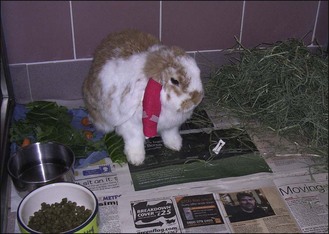3 Post-spay complications in a rabbit
Introduction
Surgical procedures involving the abdominal cavity of rabbits are historically associated with many potential complications, including wound breakdown and gastrointestinal ileus (Box 3.1). While the benefits of ovariohysterectomy (spaying) (Box 3.2) in the general population far outweigh these risks, they should nonetheless be discussed with clients before the procedure is performed on their pet. This case outlines the strong interplay between medical therapy and nursing care, and surgical treatment of complications after spaying in one individual.
BOX 3.1 Potential complications after abdominal surgery in rabbits
Case History
A day later (3 days after surgery), the rabbit re-presented at the clinic (Box 3.3). She had not eaten and had been quiet at home. Faecal output was reduced and the rabbit appeared to have abdominal discomfort.
Clinical Examination
The rabbit’s weight had reduced slightly (from 2.93 kg pre-surgery to 2.6 kg 3 days after surgery). Auscultation of the abdomen showed reduced gut sounds on the left-hand side, and a large mass was palpated in the caudal abdomen. The rabbit was reluctant to move, but did not appear to have locomotor dysfunction (Box 3.3). A moderate tachypnoea was present (respiratory rate 100 breaths/minute, normal range 32–60).
Case Work-Up
Trial with supportive care
Gastrointestinal ileus is extremely common after a stressor such as surgery. Prevention is preferable to cure, and it is advisable to administer prokinetics and assist feed rabbits after surgery until appetite and faecal output return to normal (as was done in this case). Re-instigation or continuance of prokinetics, assist feeding, and fluid therapy (see Nursing aspects box below) are indicated in a rabbit with reduced appetite and/or faecal output. An improvement should be seen within 24–48 hours. In the case of this patient, fluids were administered intravenously (Fig. 3.1).
Stay updated, free articles. Join our Telegram channel

Full access? Get Clinical Tree



